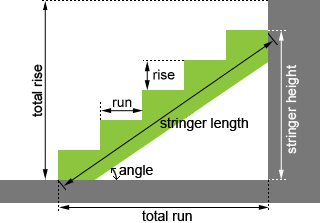Stair Calculator
Calculate step dimensions and check ergonomics based on ISO standards.
Results
| Steps | Rise | Run | Angle | Ergonomics |
|---|
Ergonomic rule: 2 × rise + run ≈ 600–640 mm (ISO 14122 standard).

What Is a Stair Calculator?
This tool calculates riser height, tread depth, number of steps, stair angle and evaluates the overall ergonomics using internationally recognized safety principles. It removes guesswork by showing which stair configurations fall within realistic, comfortable ranges used in architectural and landscape design.
Why Stair Dimensions Matter
Small variations in step proportions have a large impact on comfort and safety. Poorly balanced stairs cause uneven rhythm, increased effort or tripping risks. The fundamental design elements are:
- Riser Height: Practical range 120–200 mm. - Below 140 mm: common in landscape/public steps, but uncommon indoors. - Above 180 mm: noticeably steep for most users. - Above 200 mm: generally considered unsafe.
- Tread Depth: Typically 230–300 mm. Too shallow reduces foot contact; too deep disrupts natural stride.
- Stair Angle: Most comfortable around 30°–37°. Above 42° becomes impractical or unsafe.
- Uniformity: All risers must match—5–10 mm variance is enough to cause a stumble.
Ergonomic Formula
A well-balanced stair usually satisfies this relationship:
2 × rise + run ≈ 600–640 mmThe calculator uses this as a comfort indicator, combined with riser limits and angle checks to classify each configuration as Good, Warning or Poor.
Standards and Practical Guidelines
Most international and national standards converge on similar geometry ranges. This tool reflects common design practice:
- Riser height practical range: 120–200 mm
- Tread depth recommended: 230–300 mm
- Comfort angle: 30°–37°, absolute max ~42°
- Consistent step dimensions throughout the staircase
How to Use the Calculator
- Enter the Total Rise between levels.
- Enter Total Run if you know available horizontal space.
- Or specify a Step Run if you want a fixed tread depth.
- Choose preferred units.
- Review generated options: step count, rise, run, angle and ergonomic rating.
Examples
Example 1:
Total rise 280 cm works well with 15 steps,
producing ~18.7 cm risers, ~25 cm treads
and ~37° angle — comfortably within the ergonomic range.
Example 2:
A rise of 200 cm with 10 steps results in
~20 cm risers and a ~41–42° angle — borderline,
but still within practical limits.
Need more geometric tools? Try the Slope Calculator or Roof Calculator.